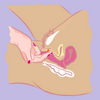Pleasure Mapping - Exploring the genital system of vagina owners

There are thousands of guides on ‘’how to improve your sexuality’’, ‘’how to spice things up in bed’’, etc., but before reading about all of these topics, there is a basic point to address: genital anatomy. Even if you think you know a lot about the genital system, you may be surprised to learn about little-known areas, their functions and their part in sexual pleasure. I won't set up a full biology class, otherwise it will take days, but let's look at some parts and ‘sweet spots’ of vagina owner's genital system to help you better understand some aspects of their sexuality .
First of all, no, vulva and vagina are not the same thing.
Think of the vulva as the pretty little package that surrounds the vagina. It’s like a beautiful wrapped present, and the vagina is the surprise inside! So, the vulva is the external part of the genitalia, and it’s made up of different parts: The mons pubis, labia majora, labia minora, clitoris, clitoral hood, urethral opening, Skene’s gland opening, greater vestibular (Bartholin’s) gland opening, vestibule, vaginal opening and the perineum.
On the other hand, the vagina is the internal canal that connects the cervix (the lower part of the uterus) to the vulva. There are other internal organs that play an important role in the sexuality of people with a vagina like the cervix, uterus, fallopian tubes, etc.

The Clitoris
The clitoris is the pleasure center of the vulva. It doesn’t have a central role in reproduction like the penis or vagina — it’s pretty much just there to make you feel good! It’s a highly sensitive organ located right under the point where the inner labia meet and form the clitoral hood, above the vaginal opening and the urethra. The part that you can see is actually just the tip of the clitoris (called the glands). It is made up of thousands of nerve endings and is the only part of the human body that exists solely for pleasure! During sexual arousal, the clitoris, made of spongy tissue becomes engorged with blood, making it swollen, more sensitive and easier to stimulate. The rest of the clitoris spongy shaft extends inside the body, back and down along both sides of the vagina. This part, called the shaft and crura (roots and legs), is about 5 inches long.
One way to stimulate it is through manual stimulation. Start by gently rubbing the clitoral hood (the small flap of skin that covers it). Then, using a circular or back-and-forth motion, you can apply pressure to the clitoris itself. Experiment with different speeds and pressures to find what feels best for you. This can also be done with different sex toys made for external pleasure. Another way to stimulate it is through oral sex. Lightly licking, sucking or kissing the clitoris can be incredibly pleasurable.

Skene’s Glands
Skene's glands (also known as the lower vestibular glands, the periurethral glands, the U-spot and the female prostate) are a pair of glands located on either side of the urethra in the anterior part of the vaginal wall. The tissue surrounding Skene's glands includes the part of the clitoris that extends into the vagina and swells with blood during sexual arousal. The ducts of these glands then empty into the urethral canal and can then be ejected through the two small orifices (often as a result of G-spot stimulation) which, as mentioned above, are located on either side of the urethra. Many feel a certain urge to urinate when these glands are stimulated as this puts some indirect pressure on the bladder. There is no need to worry - their function is to secrete a translucent liquid to lubricate the urinary meatus and act as an antimicrobial. This makes it almost impossible to urinate during intercourse. Continue to read to see how to activate them by stimulating the G-spot!
Inner Lips (labia minora)
The main role of the labia minora, by their position around the vulva, is to protect the clitoris, the vaginal entrance, the vestibule and the urethra. Their funnel shape indicates how to reach the vaginal entrance. During sex, the shape of the labia minora also changes. Like the penis, they swell and unfold during arousal due to the influx of blood as they contain erectile elements. Their color may also darken at this time and they may remain swollen for several minutes after the end of intercourse. The labia minora and majora are an erogenous zone in their own right because they are highly innervated (contain many nerve endings) as they are connected to and covering the clitoral bulbs. Under the effect of pleasure, the inside of the labia minora moistens and a "vestibule" is formed to facilitate penetration. They therefore have a real role in sexual pleasure. Remember: wetness is an important friend to the inner lips– it is not a place to mess with if there is no lubrication. We highly recommend using lube.
Bartholin’s Glands & V-Spot (vestibule)
Also known as vestibular glands, Bartholin’s glands are the counterpart of the bulbourethral glands in people with penis. They are two pea-sized glands located on either side of the vaginal opening, which have the function of secreting a mucus-like substance into the vagina and within the borders of the labia minora, following sexual stimulation. This serves to moisturize the vulva and lubricate during sexual arousal in order to avoid friction, lacerations and the infiltration of certain bacteria (this is also one of the reasons why it is VERY important to stimulate another way than by penetration before intercourse). They are thus essential to the good intimate and sexual health of people with a vagina.
Associated with those, the V-spot is the gateway to the vaginal canal and the entry point for penetration. “V” stands for vestibule, which is the skin surrounding the opening/entrance into the vagina. It is the area past the inner lips at the base of the vaginal canal. Once again, we are all different, but for many, not only are there a lot of nerve endings in this part of the body, but they tend to be very close to the surface. This vaginal erogenous zone is so important because it’s essentially the indicator of whether or not your body is feeling excited and ready for penetration. Some people even prefer the stimulation of this area than the deeper one.

G-Spot (internal clitoris)
The G spot is not a separate and specific part of the anatomy but part of the larger clitoral network. This means that when you’re stimulating the G spot, you’re stimulating part of the clitoris, which is much larger than we’re led to believe. The pea-sized nub where the inner labia meet is only the tip of the clitoris and divides into two “roots” that can be about 5 inches long. It is also connected to the urethral sponge and Skene’s Glands; its proximity and relationship with those explains why stimulating this erogenous zone is often the key to “squirting,” or ejaculating . This G-spot exemplifies how many vaginal erogenous zones are interconnected and overlapping, creating an elegant and complex system of sensation, engorgement, and pleasure. Plus, this region can vary from person to person which explains why it can often be difficult to locate.That doesn’t mean it’s impossible.
Instead of searching for it during partnered sexual activity, it’s easier to locate the G spot through self-exploration. The G-spot typically has a more ribbed texture to the touch. To find it, start massaging the opening of the vagina. Then, using fingers, lift upward toward the belly button in a ‘come here’ motion. You may feel a slight bump or a ridge that is more sensitive than the surrounding tissue. Remember, you are not trying to push a specific button, but rather find what works best for you in that general area. You can also use a curved dildo or a g-spot vibrator to help you get there.
A-spot
The A-spot is an erogenous area that sits deep within the vagina, located on the inner wall, next to or just underneath the cervix. You can find it past the G-spot on the same anterior wall of the vagina. It is indeed an area rich in nerve endings and blood vessels. For some, this area can be very sensitive, bringing another level of pleasure, while for others it will bring little sensation. Each one is made differently, but also, our sensations towards this zone vary over time. This can be explained by the fact that the location and sensitivity of your cervix changes throughout the menstrual cycle and/or state of arousal. It will feel very different during sexual penetration at different times in your cycle. Typically, the cervix is softer and higher in the vagina during ovulation, and in a lower more rigid position during and after menses.
Stimulating the A-spot during sex will be easier in positions that allow for deeper penetration. You can use fingers, a penis, a G-spot stimulator, a curved dildo that will allow you to go deep in the vaginal canal with the right angle. Don’t forget to breathe, be well lubricated, already aroused and to stop if you feel any pain or discomfort.
O Spot (cervix)
The O-spot (sometimes called the C-spot) is located close to and directly on the cervix, and can be a tricky place to reach. The cervix is at the base of the uterus deep inside the vaginal canal. If you found the g-spot, rotate your finger toward the opposite wall and go a little deeper until you feel a spongy area on the back wall of the vagina. That’s the O-spot. The key to stimulating the O-spot is via pressure, which can trigger a Cervical Orgasm. The O-spot can be the source of much of the pleasure during vaginal penetration, but some people are very sensitive to having their cervix touched, and too much banging against the cervix can cause bruising and pain. This vaginal erogenous zone can also be accessed during anal play, because of its posterior location in the vagina. Like the A-spot, exploring the O-spot is a chance to try out some different positions to see what kinds of pleasure or orgasms you can have.
The Perineum
The perineum is located between the vagina and the anus. Internally, it is located below the primary muscle of the pelvic floor and it stretches across the pelvic bones. The average perineum is about 1.5 inches (in) long if you’re AFAB (cisgender women, transgender and nonbinary people with vaginas). An important nerve called the pudendal nerve runs through the perineum and branches out into various parts of the anatomy, including the vagina, pelvic floor muscles and anus. This complex nerve network makes your perineum sensitive to sexual sensations. It makes it an erogenous zone, as it contains multiple nerve endings that help with sexual arousal and response both inside and on the outside skin.
To massage it internally, press both thumbs on the back wall of the vagina toward the anus. Applying enough pressure to feel slight stretching within your vagina. You can move both thumbs slowly in a U-like motion so that you feel a gentle stretch.
Pelvic Floor Muscles
The pelvic floor muscles are made up of both superficial and deep layers and muscle located at the base of your pelvis. They extend from the pubic bone to the tailbone, from sit bone to sit bone, and they surround the opening of the anus, vagina, and urethra. The more superficial layer is also known as the urogenital triangle. Two muscles called the bulbospongiosus and the ischiocavernosus aid in orgasm. In people with vagina, these muscles actually feed into the clitoral hood and participate in contracting the clitoris against the pubic bone in order to achieve enough friction and feedback to produce orgasm.
The pelvic floor muscles surrounding the vaginal opening must be able to do 3 things during penetrative sex:
- Relax (aka lengthen) and remain relaxed to allow for pain-free penetration
- Tolerate stretch to fit a toy or penis
- Contract fully to help produce an orgasm
To train the pelvic floor, kegel exercises can be done as explained here: Kegel Exercises
There are planty other parts that are good to know, but I think this is a great start. Not only this can be benifical for your general knowledge, but it can also help improving communication, increased pleasure, enhanced safety and reduced performance anxiety. Knowledge of one's own body and the bodies of others can also lead to a sens of empowerment and confidence in sexual relationship. Enjoy the exploration!
Sources:
• Atlas 3D. (N.D.). Anatomy.tv http://www.anatomy.tv/titles, Copyrights via Université Laval.
• Hoare BS, Khan YS. Anatomy, Abdomen and Pelvis, Female Internal Genitals. [Updated 2020 Jul 31]. In: StatPearls [Internet]. Treasure Island (FL): StatPearls Publishing; 2020 Jan-. Available from: https://www.ncbi.nlm.nih.gov/books/NBK554601/
• Nguyen J, Duong H. Anatomy, Abdomen and Pelvis, Female External Genitalia. [Updated 2020 Aug 10]. In: StatPearls [Internet]. Treasure Island (FL): StatPearls Publishing; 2020 Jan-. Available from: https://www.ncbi.nlm.nih.gov/books/NBK547703/
• OpenStax (2019), Anatomy and Physiology of the Female Reproductive System, Anatomy and Physiology, OpenStax CNX. Repéré au http://cnx.org/contents/14fb4ad7-39a1-4eee-ab6e-3ef2482e3e22@15.5
• Tullington JE, Blecker N. Lower Genitourinary Trauma. [Updated 2020 May 22]. In: StatPearls [Internet]. Treasure Island (FL): StatPearls Publishing; 2020 Jan-. Available from: https://www.ncbi.nlm.nih.gov/books/NBK557527/
• Yavagal, S., de Farias, T. F., Medina, C. A., & Takacs, P. (2011). Normal vulvovaginal, perineal, and pelvic anatomy with reconstructive considerations. Seminars in plastic surgery, 25(2), 121–129. https://doi.org/10.1055/s-0031-1281481
• Wikimédia Communs. Repéré au https://upload.wikimedia.org/wikipedia/commons/f/f8/Scheme_female_reproductive_system- fr.svg
• Contributed by Gray's Anatomy Plates From: Anatomy, Abdomen and Pelvis, Female Internal Genitals Cover of StatPearlsStatPearl
- https://www.verywellhealth.com/female-body-diagram-5209032
- https://tocatocatoca.com/vaginal-erogenous-zones-mapping-the-road-to-pleasure/
- https://hermd.com/sexual-pleasure-your-pelvic-floor/
- https://www.healthline.com/health/healthy-sex/erogenous-zones
- https://www.menshealth.com/sex-women/a19534447/her-pleasure-zones/





